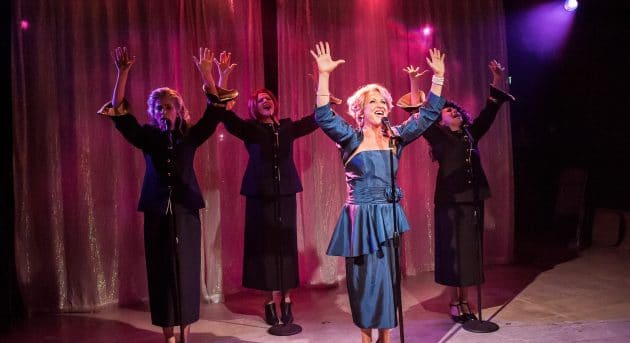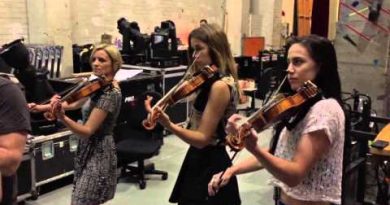Review: Miracle City – Hayes Theatre Co
Miracle City is the stuff of legends in the Australian musical theatre community. A show that was staged just once at Sydney Theatre Company in 1996, it played to rapturous audiences… and was never seen again. Stories of this amazing musical have persisted, and one of the songs in particular has persisted, popping up in cabarets and benefits ever since (it was even sung at Hats Off! earlier this year), but the show and hope of further development was shelved when Nick Enright, who wrote the book and lyrics, passed away.
But something like a miracle happened, and Hayes Theatre Co has managed to bring it back to us with all the appropriate blessings. Composer Max Lambert is musical director, and Darren Yap, who worked on a workshop of the show with Enright in 2007, is here to direct, incorporating changes he and Enright made during WAAPA workshop. It’s a labour of love, produced and staged and performed with love, and it is love that brings this show to vivid life.
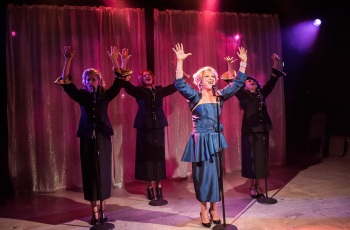
It is superb.
Staged in real time, which makes everything and everyone onstage somehow undeniable, Miracle City centres on the Truswells, a family ministry in Johnson County Tennessee, with their own Sunday morning praise show, a road team spreading their message, and dreams of building a theme park (“first you pray, and then you play”).
The patriarch is Ricky (Mike McLeish), a reformed delinquent who found God in prison and his wife Lora-Lee (Blazey Best) in the back of the visiting preacher’s truck. Lora-Lee has been raised in religion and is a Good Woman and Good Wife; her public face instructs ladies watching to “find the God in your man.” On the Sunday we spend with them, it is the couple’s anniversary.
They have two children, Loretta (Hilary Cole) and Ricky-Bob (Cameron Holmes), who do their own ‘bible stories for kids’ segment on the show, sing along with the numbers, smile a lot to indicate happy-family status, and who are devoted to their parents.
On their broadcast, they’re joined by Billy Trengrove (Jason Kos), stagehand and right-hand man, he hopes, to Ricky. And they’re backed by their Citadel singers – women from the community who seek joy in Christ, who sing for their life and their family. Eulella (Marika Aubrey) is a mother raising children who has no time for anyone’s nonsense; she’s the centre of the trio, calm and authoritative. Charlene (Josie Lane) is bubbly, excited about life and God and beauty school. And then there’s Bonnie Mae (Esther Hannaford), a recovering addict who lost her child to the county and wants so badly to get her back and to have something to believe in. She joined the group by calling in as a congregant watching the show, desperate for prayer and salvation.
The thing is, that unshakable faith at the core of everything these people do – the thing that has drawn them together for the broadcast and as a family – this sense of faith, of trust that life will be okay, that things happen for a reason – turns out be very shaky indeed.
The first crack in the be-wigged, heavily makeup-ed veneer comes from a stressed out Ricky: the theme park has the family bleeding money, and Ricky’s trying not to let on. He only lets on how deep that financial hole actually is when saviour comes in the form of renowned preacher Millard Sizemore (Peter Kowitz). He’s a man of fire and brimstone and damnation if there ever was one, over fifty and intimidating, and it’s when he offers to help with the finances that everyone is really, deeply tested. He’ll help the family, but only if he gets something in return. And that something he wants is sixteen year old Loretta, with her ribbons and bows and pure voice.
Not everyone’s stomach will turn at this prospect, and that’s when the miracle city, that hasn’t even been built yet, starts to tumble down.

The show goes on despite this proposed deal – the show always goes on – but we soon learn that no one is what they seem on camera. We soon learn, to be specific, that blind happiness isn’t blind at all. We soon learn that no matter how hard you pull yourself by your bootstraps to make a better life and be pious, it won’t necessarily make you a good person. Success doesn’t resolve your spiritual weaknesses. In fact, it’s possible that in this ministry, all it does is excuse them.
When people are tested and their beliefs are challenged, when their support systems disappear, they reveal themselves – they revert to being who they really are. When there’s nothing else to tell you what to do, you have to listen to yourself whether you want to or not, and Lora-Lee takes us deepest in this self-reflective journey. Lora-Lee and the remarkable Blazey Best.
Best is a masterful actress and a beautiful singer; she brings a touching naturalism to everything she does on stage, even when she’s a larger than life woman who is loosely based on Tammy Faye Bakker. She holds the audience in the palm of her hand as she looks at her daughter, her husband, her family and her empire, and tries to re-orient herself back to the centre of her own life after she’s been shaken. Lora-Lee is the most clearly defined and deeply-felt character in the show and Best makes her so real it’s heartbreaking.
Her progression through the show feels more successful than Ricky’s and McLeish’s, partly because his performance is a little too outsized for Best’s, and partially because the book favours Best, but he has an appealing affability that hints at potential malevolence; it’s a curious thing, this wondering if he does indeed intend to give his young daughter to Sizemore. Kowitz as Sizemore is stentorian, alarming in the way he doesn’t smile into the cameras like everyone else; he is genuinely menacing.
Cole’s performance lexicon grows into something more complex every time she steps on stage; she is better every single time. Her voice in Miracle City is so reverent and sweet and her acting is layered and complex; if she was a shockingly good talent a year ago in Carrie she’s a force to be reckoned with now. Holmes brings to her brother Ricky-Bob a good mix of youthful innocence and a palpable love for his family; he’s a mature performer and a great find.
Hannaford, Lane and Aubrey understand how their performances affect each other’s; they’re a perfectly calibrated trio. Lane’s chipper youthfulness and flamboyant devotion provides important contextual contrast to Hannaford’s tremulous songbird Bonnie-Mae. It’s a key clue in telling is who these women are when they are supporting characters without as much time to be explored; Lane is saved, or thinks she is, and Bonnie-Mae isn’t so sure. It makes their later scenes so much more successful. Aubrey keeps them connected as two sides of the same coin by being the one holding the coin firm. Aubrey’s Eulella delivers her line with a fresh assurance that tells us, clearly, that she’s earned everyone’s trust. There’s nothing wavering about her, and nothing needlessly cheerful either; she’s possibly the only person in the entire show, except for Sizemore, that has perfectly come to terms with who she is.
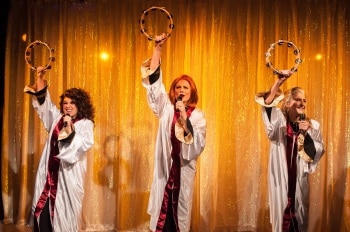
One of the most compelling things about Miracle City is that it completely subverts the function that music typically serves within a musical, and that the way it breaks and re-interprets this rule is entirely in service to the story, and it creates when you watch it a breathlessness and a sense of urgency aided by the real-time framework; for a minute, you don’t know where to look, or what to listen to, to find the truth behind the characters.
Songs within musical theatre, generally and broadly speaking (Miracle City is not the only exception, but it’s an excellent one, and one of the most successful) are designed to advance the plot or illuminate character development. A character sings, the common refrain goes, because their situation is such that speaking is no longer enough. Songs are our ‘in’ to hidden desires – the number following the opening number is generally the ‘I want’ song, so you know what the motivations of your protagonist/s are – and allows the characters, and audiences along with them, to fall into the love, the conflict, the despair of the lives onstage. The song in musical theatre, generally, is emotion heightened to its purest sense, to a common language of song and music that we can easily connect with.
Miracle City, though, doesn’t do this. This is not what Miracle City is all about.
Miracle City has a very clear rule at its core and it’s this: the TV show being filmed as the driving action of the show is not real. It is not the source of truth; the answers aren’t in the sketches and segments and “amen”s. When the camera is pointed in someone’s face, they become less authentic and more polished. The show is the artifice; the family backstage is real. And if this is the rule at the heart of the show, then for the show to truly be a great one, and to treat its story seriously, this rule must extend to the music. Thankfully (blessedly) it does.
The songs in Miracle City are part of the broadcast and that is where they stay: in the foundation of the thing the family is desperately trying to keep together. The songs are not the story, but the songs are not then made superfluous; the story happens despite the songs. The characters unravel but they have to pull together, praise someone that’s sure as hell not helping them, and then fall away from that joy of being saved back into the mess pooling around their ankles and rising.
The songs are beautiful. Enright’s lyrics and Lambert’s music are so refreshingly, imperatively well-crafted. The gospel influence allows the voices of the cast to weave through the air like kites, trailing and trilling and riffing to the Lord/camera (which one do they worship, anyway? At the end, for some, it’s quite hard to tell). “Raise the Roof” is rousing, the kind of celebration of life that prompts a smile. “To Arms” is more sombre, and commanding, the weight of militant religion on its shoulders, which makes it so fitting that it’s basically Sizemore’s theme song.
Kelley Abbey’s choreography is light and feels expansive, even though it’s actually strictly contained – you never notice the confines of the small space of this makeshift studio even with an abundance of dancing and movement, which borrows from sign language to achieve a surprising amount of grace.
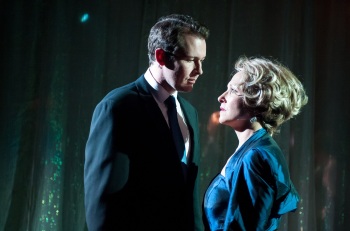
The set is brought to clever life by Michael Hankin; you never quite buy its glitz, all gauzy curtains and warm light (by Hugh Hamilton) but when you do see it finally without all the showy lights and excitement and power of performance, it’s a gut-punch that feeds perfectly into the emotional climax of the story.
That’s the hidden surprise of the songs – the parallels between story and song aren’t overt and aren’t heavy-handed in the least. But there’s a sacrificial motif when the children sing their number that’s apt (though it’s more impressive that it appears innocuous but is disturbing below the smiles on the kids’ faces, which mirrors even more closely the behaviour of the adults). There’s a delicate, genuinely sad irony to ‘I’ll Hold On,’ Bonnie-Mae’s song of a redemption she doesn’t believe in; Hannaford sings it like someone who believes in their voice but not in their salvation. There’s an endless vulnerability to her that makes her final appearance onstage all the more satisfying.
Yap’s direction makes a sharp image out of a densely-cluttered landscape. Framing this story, where a constant rolling TV show has to take place at all times, as well as the life of the characters on the fringes of the studio action, is a potentially dangerous game. It would be easy to muddle this, to lose the quiet off-screen conversation and searching looks in the sounds of gospel, but Yap knows how to walk this line and never loses sight of the through-line of the story, of the characters. He asks a lot of his actors and they don’t disappoint; they are utterly committed and he has brought out in them all such clear demonstrations of their talent.
Miracle City is the third Australian musical in Hayes Theatre Co’s first year in operation and their second revival of Australian work. Their commitment to providing a platform for Australian musicals was part of their mission statement and they are delivering so impressively. To give us a new work (Truth, Beauty and a Picture of You) and a revival (LOVEBiTES) is a much-needed injection of support and exposure to Australian artists. To then give us Miracle City, to bring back a work that we thought lost, that is collectively remembered as one of our best, is a true and magical gift.
Miracle City is a triumph of Australian musical theatre and this production at the Hayes, when it swells to its conclusion, touches the sublime.

